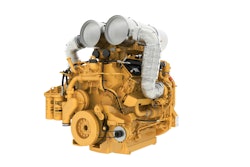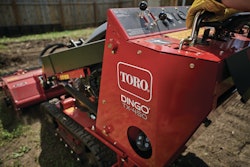After two record-breaking hurricane seasons, it’s becoming apparent that flood and water damage pose a threat to heavy equipment fleets. And it’s not just the Gulf Coast that’s at risk. Days after October’s Hurricane Wilma roared across southern Florida, torrential rains and floods struck from New England to New Jersey. Shortly after that, mudslides deluged parts of Los Angeles. Late winter gully washers are common in the desert southwest and spring snowmelts often bring floods to the upper Midwest.
While heavy equipment is rugged enough to withstand hard rains, floods, deep water and wind-driven rain can penetrate the best defenses. When the water gets deep enough, breather tubes, blow-by tubes, seals, fill caps and filters can be breached. Studies by Florida homebuilders have shown that sustained hurricane-force winds can drive rain completely through concrete-block walls. So even if you have equipment or supplies stored inside a covered facility you’re still at risk for water damage.
Oil and water don’t mix
Water contamination can be obvious or not so. Either way, it’s bad for your machines. “Water is a terrible lubricator,” says Dan Arcy, technical marketing manager for Shell’s heavy-duty motor oils.
What’s more, excessive water destroys the effectiveness of engine lubes, gear oils and greases. In a sump or compartment, water can displace lubes and fluids – giving you the illusion that you have sufficient reserves. But once the component heats up, the water evaporates, leaving your engine or component dangerously dry. Water in hydraulic fluid will cause pump cavitation, and water contamination also dilutes or changes the pH of coolants. It’s also important to remember flood or standing waters leave in their wake a residual stew of contaminants like silt and dirt, chemicals and organic debris. These can work their way into the tightest compartments and cause slow, difficult-to-detect damage to components long after the water has been cleaned out.
Salt water is especially damaging as it introduces chlorine, a caustic and corrosive element, into the internal chemistry of your engines, powertrains and hydraulics, says Jon Rummel, manager of products technology and services for Citgo.
Hydraulic systems are particularly sensitive to water contamination and usually lack water separating filters, Rummel says. “Just 500 parts per million of water in hydraulic fluid can cause from twice as much to 50 times as much wear in a vane-type pump as dry hydraulic fluid,” he says. And as little as 20 ppm can reduce the life of anti-friction bearings in the pumps and motors.
You don’t necessarily need a big flood or hurricane to experience water contamination. “I just cringe when I see somebody driving through water up to their bumpers,” Arcy says. “The water’s going to get sucked in through the breather tube and get into the transmission.”
Assessing site damage
After you’ve done a thorough safety and hazard reconnaissance of the area in question (see sidebar below) you can start looking for the obvious visual clues of water damage and contamination. Look for high-water-mark stains on walls or debris in trees or shrubs, and relate that to where your equipment or lube supplies were sitting.
“If water has come up to the wheel bearings or axle level there is potential for water to get through a seal or breather tube or fill tube,” Arcy says. “The same holds true for bulk lubricant if you have in-ground tanks or flood water went over the fill tube.”
Vernon Solis, marketing advisor, fleet and off-highway for ExxonMobil Lubricants & Specialties, recommends you also look for stains or discoloration on the ground under equipment or supplies. This would indicate the water found access to and displaced the lubricant. Stains can help you pinpoint the contamination and prioritize your efforts, Solis says.
Looking for cloudy oil
Next you’ll want to inspect specific machine compartments. Pull the engine dipstick and examine the color of the oil. If it’s milky or cloudy, that indicates water – good oil will be clear and bright. Also, if the oil level is too high, chances are there is water in the crankcase that has displaced the oil, says Eric Bevevino, business manager, industrial & integrated solutions for Chevron Global Lubricants.
“Engine oils have additives in them that help lock in small amounts of water, which is why it will turn cloudy,” Bevevino says. “But it doesn’t help you much in a flood or hurricane because it makes the engine oils that much more difficult to save or treat.” In most cases, water in the oil means the oil will have to be thrown out.
Hydraulic oil, greases and gear oils
Hydraulic oil, grease and gear and transmission oils repel or separate from water, especially if they’re left alone, Bevevino says. For differentials and other types of gear boxes this means you can sometimes drain the water from the bottom of the housing. (But remember this doesn’t solve the problem of silt and other contaminants.) So in most cases if water contamination is suspected, the component will need to be drained, cleaned and dried according to the equipment manufacturer’s recommendations before refilling with new oil.
If you don’t have any visual clues, one quick-and-dirty way to detect contamination is to do a crackle test. In a crackle test you put a drop or two of the oil in question in the bottom of a metal container and warm it with a lighter or torch. A crackling sound indicates the presence of more than 0.1 percent water, which means the oil needs to be thrown out.
Some of the heavily formulated engine oils can bubble during such tests and will not have a sharp crackle, says Rummel, hence may not yield conclusive results. Also engine oils taken from an engine’s crankcase or sump (as opposed to stored oil) may contain traces of fuel and trying a crackle test of these may create a fire hazard. Ask your lube oil provider to demonstrate the proper procedures and safeguards before attempting a crackle test on your own.
Lithium complex and moly greases typically used on heavy equipment are water resistant, but prolonged exposure to water can leach additives out of grease and compromise their performance, Rummel says. And the cartridges that grease comes in are usually made of fiberboard that can deteriorate after prolonged contact with water, he says.
Lubes in storage
Storm waters may not have as many entry points to get into and contaminate stored oils and supplies, but this needs to be checked also. Supplies exposed to water for short periods of time can often be salvaged if the water hasn’t emulsified into the product. But the longer the water sits in contact with the product the more likely it is to leach out additives – and the chlorine in salt water can change the chemistry.
Since all the products being discussed here are lighter than water, water that does creep into bulk storage bins or drums will usually settle to the bottom of the container. Your best bet is to drain this water off. Once you’ve drained off the free water or verified that there isn’t any, Solis recommends you take samples of the fluid from the top, middle and bottom of the container. A device he calls a “Bacon Bomb” (a small sampling device that’s lowered on a line into the fluid) can help with this all-levels sample. An oil sampling vacuum pump, sometimes called a vampire pump, can also be used to collect samples at different levels.
The samples are stored in clear jars and examined for signs of cloudiness. If you let these samples sit undisturbed for 24 hours you may also see signs of water separating out.
Oil analyis recommended
Small amounts of water or contamination may not always be visible, in which case you can turn to traditional oil sampling and analysis to determine if the fluid is still usable. And because you’re also looking for contamination that normally doesn’t occur in these fluids, Solis recommends you include an ISO cleanliness test by particle count to the list of items you normally ask the lab to perform.
Getting back to business
If water or contaminants are found in your machines’ compartments, you need to work with your equipment dealer on the cleanup procedures. Just draining a compartment and refilling it with clean fluid and changing the filters is usually not enough. Reservoirs typically need to be flushed and then dried with lint-free absorbents. Desiccant breathers should be installed, especially on hydraulic systems, to pull any remaining moisture out of the system. Depending on the size and complexity of your equipment, the dealer may want to use a borescope or digital photography to examine inaccessible regions of the engine or component. You’ll also need to have the electrical systems and onboard computer systems examined and tested for integrity.
One procedure you can usually do yourself is to purge grease fittings of contaminated product. To do this Solis recommends you wipe the fittings clean, apply about one and a half times the usual amount of grease to the fitting and examine and verify a complete color change at all grease purge points (since water will discolor grease). Wipe off the contaminated grease and do your next few regreasings twice as often as normal. If any of the fittings don’t accept grease, assume that contamination has caused a blockage and perform the OEM-recommended maintenance.
If contamination is found in stored products there are service providers who can, through vacuum dehydration and other methods, restore these lubes to good working order. Consult your lube supplier.
This is not your usual safety briefing
Faced with the chaos left behind by a flood or hurricane, the natural impulse is to jump in and start cleaning up. But before you do so you need to pause to evaluate a whole new set of hazards you’re probably not familiar with.
“‘Do it safely or not at all,’ is a key phrase we use every day that has particular importance in these times of crisis,” said Eric Bevevino, business manager, industrial and integrated solutions for Chevron Global Lubricants, in a memo to employees following Hurricane Katrina in August. “Lack of sleep, sensory overload, dehydration and food shortages can combine to destroy our attention to detail and cause injury,” he said.
The hazards Bevevino warns of include:
- Water and electricity
- Toxic and explosive gasses
- Prolonged skin exposure to oil, chemicals and waste products
- Dangerous animal life
Bevevino urges crews to make a thorough assessment of these hazards at any site before starting cleanup efforts. Steel-toed safety shoes or boots with metatarsal protection are recommended and steel-lined soles will help protect against nail punctures. Coveralls, long-sleeve shirts and gloves also provide protection against minor cuts and scratches that can quickly become infected with the increased bacteria levels in flood water. Bevevino says these recommendations came from the company’s experience when Chevron volunteers helped clean up in Pennsylvania following the floods spawned by Hurricane Ivan in 2004.
Prevention is the best medicine
In severe weather events there is not much you can do to prevent water from pounding its way past your machines’ defenses. But the way you store your bulk lubes and other products goes a long way toward keeping them safe and clean.
“If you’re using drums and they’re full, store the drum on its side, off the ground and with the bung holes horizontal,” says Dan Arcy, technical marketing manager, Shell heavy duty motor oil. This minimizes the chance that air and water will get in. “If they’re sitting on their base, water collects on the tops. A large temperature change can create a vacuum inside the drum,” he adds. If drums must be stored upright, the use of plastic drum covers can help keep water from collecting on the tops. And whenever possible store your supplies and drums inside or under a roof.










